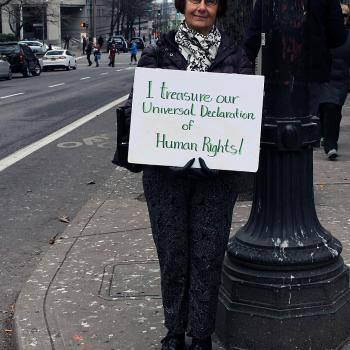 Muted in the popularity (or controversy) of other films released in 2005 like Brokeback Mountain, Crash, or Hustle and Flow, a simple western film showed audiences the difficulty and power of forgiveness. Directed by Tommy Lee Jones, The Three Burials of Melquiades Estrada proved his worth both behind the camera and in front of it as well. The film received much critical acclaim, but as a contemporary film, its theological implications have yet to be explored. In his directorial debut, Jones uses the borderland of Texas and Mexico as a palette on which he paints a critique of the “American dream,” commentary on immigration, and an imaginative view of forgiveness and reconciliation so desperately needed in both these issues. By walking this imaginative path to forgiveness, this film shows, in one way, how we as a society may break the cycles of violence that enslave us.
Muted in the popularity (or controversy) of other films released in 2005 like Brokeback Mountain, Crash, or Hustle and Flow, a simple western film showed audiences the difficulty and power of forgiveness. Directed by Tommy Lee Jones, The Three Burials of Melquiades Estrada proved his worth both behind the camera and in front of it as well. The film received much critical acclaim, but as a contemporary film, its theological implications have yet to be explored. In his directorial debut, Jones uses the borderland of Texas and Mexico as a palette on which he paints a critique of the “American dream,” commentary on immigration, and an imaginative view of forgiveness and reconciliation so desperately needed in both these issues. By walking this imaginative path to forgiveness, this film shows, in one way, how we as a society may break the cycles of violence that enslave us.
The Three Burials tells the story of two friends, Pete Perkins (an American) and Melquiades Estrada (an illegal Mexican immigrant), both of whom work on a cattle ranch in Texas. They form a fast friendship that culminates in Pete’s promise to Melquiades to bury him in Mexico if something ever happens to him. Unfortunately, their friendship is tragically broken when Mike Norton, a rookie border patrolmen, accidentally shoots and kills Melquiades, forcing Pete to uphold his promise. Jones flashes back and forth between scenes around Melquiades’ death and scenes of his friendship with Pete for the first part of the film. The majority of the film, however, follows Pete’s journey back to Mexico to bury his best friend, a journey full of theological implications.
First, a note on the film’s socio-political commentary. Jones critiques the “American dream” through the vacuous Norton marriage, an incompetent legal system (symbolized by Sheriff Frank Belmont), and an unfaithful truck stop waitress who has affairs with both Pete and Sheriff Belmont. In terms of immigration, the film presents a porous border and is unwilling to locate itself in either Mexico or the United States, and indeed, the failures listed above serve as the strongest “American locators.” The film’s dual depiction of border patrol officers as either violent, vigilant, and unforgiving or apathetic and racist further comments on the immigration issue. Critics like Roger Ebert, Jonathan Rosenbaum, Manohla Dargis, and Mick LaSalle all hint at the film’s stinging socio-political critique. Some critics even suggest at spiritual or religious themes in the film: for example, in his review of the film, Roger Ebert notes, “[…Pete] takes justice into his own hands. And not simple justice, which might involve killing the agent [Mike], but poetic justice, which elevates the movie into the realms of parable.” However, most critiques begin to crumble when they approach anything resembling the religious or spiritual.
The film offers its main theological contributions in Pete’s journey to Mexico to bury Melquiades. Pete does not make the journey alone, forcing Mike to come with him as part of his punishment. Rather than having Pete kill Mike in revenge or having him punished by the state, the film envisions a punishment for Mike that produces both forgiveness and redemption/reconciliation. Pete’s punishment is a specific response to the particular evil that Mike committed, rather than a generic, impersonal one. By placing The Three Burials in conversation with a contemporary theological text, Marjorie Suchocki’s The Fall to Violence: Original Sin in Relational Theology, we see theology’s ability to enrich our film-watching and also film’s ability to strengthen theological discourse. Suchocki’s understanding of the relatedness of humanity and her redefinitions of sin and forgiveness places this film in a new, refreshing light. Of sin, Suchocki’s writes: “Sin is the violence of rebellion against creation. Sin is unnecessary violence against any aspect of existence, whether through act or intent, whether consciously chosen or otherwise. Sin is the violation of creation, and therefore rebellion against creation’s well-being. Insofar as creation involves God as creator, sin also entails a violation against God” (16). In light of this definition, our perceptions of sin, victims, and violators in the film become simultaneously clearer and more complex. To be critical of Pete, his punishment of Mike is not without violence of its own; however, Mike brings much of this violence upon himself by trying to resist this proper form of punishment.
Of forgiveness, Suchocki adds: “To forgive is to will the well-being of victim and violator in the fullest possible knowledge of the nature of the violation. Forgiveness, then, is the exercise of transcendence through memory, empathy, and imagination; it is the hope of our humanity since it wields the power to break the cycles of violence. The event of forgiveness is a lifetime investment in naming ourselves and each other as we are and as we can be in the continuing evolution of humanity” (14). If Pete and Mike’s journey to Mexico seemed unique on its own, when placed in conversation with Suchocki’s definition of forgiveness, it becomes a journey of memory, empathy, and imagination. Pete “forces” Mike to empathize with Melquiades by having him sit at his table in his shack, to wear his clothes, and to drink from his cup as they depart for Mexico. This process of forgiveness is a memorable one (as is the film) with Melquiades’ rapidly-rotting corpse along for the ride. Finally, the journey to Mexico is an imaginative one because Pete’s punishment of Mike does not kill or demean him but ultimately brings him back to life and affirms Melquiades’ life in ways totally antithetical to a prison sentence or the electric chair. Thus, The Three Burials transcends a long line of revenge films into which it could have so easily fallen.
The Three Burials of Melquiades Estrada calls into question the treatment of Mexican immigrants in the United States, the ideal of the American dream, and mindless forms of punishment often fueled by revenge. In doing so, the film presents a corrupt, broken world full of victims and violators often indistinguishable from one another. Yet it also holds out hope, presenting another way of being in the world, revealing a path to forgiveness that we can all walk with memory, empathy, and imagination.














